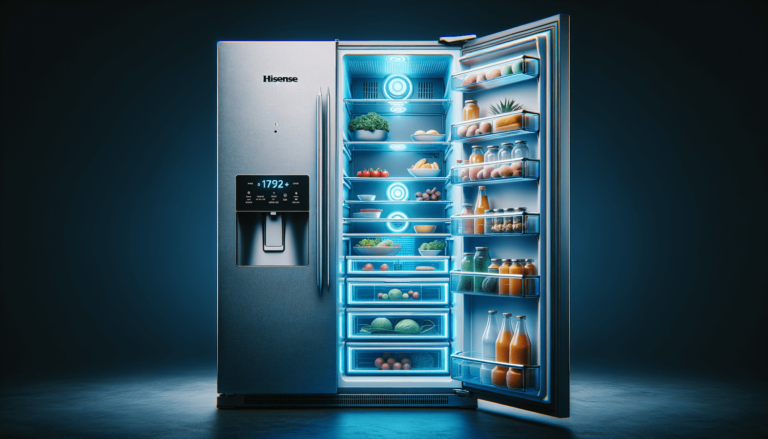

Welcome to our comprehensive guide on Hisense Refrigerator Settings Explained. Nowadays, refrigerators come with a variety of features and settings to help you preserve your food in the best possible way. However, understanding these settings can be confusing. In this blog post, we will decode the mystery behind the different settings of your Hisense refrigerator and teach you how to make the most out of them. Just like in our previous post about Bosch Refrigerator Settings, we aim to provide you with clear and concise
Hisense refrigerators typically offer temperature settings for the fridge and freezer compartments. Adjust these settings according to your needs and the recommended temperature ranges – fridge: 35-40°F (2-4°C) and the freezer: 0°F (-18°C).
These modes rapidly cool or freeze fresh groceries to lock in nutrients and flavors:
This feature alerts you when the refrigerator door is left open for an extended duration, helping conserve energy and maintain the desired temperature.
Use this energy-saving mode when you’re away for an extended period. It deactivates the fridge compartment and maintains the freezer at its optimal temperature.
This feature locks the control panel to prevent unintentional setting changes by children or during cleaning.
Energy-efficient LED lights brightly illuminate your fridge, making it easy to locate items and check the temperature.
Hisense refrigerators use frost-free technology or total No Frost, preventing ice buildup and eliminating the need for manual defrosting.
This system circulates cold air evenly throughout the refrigerator, ensuring consistent temperature and humidity levels for better food preservation.
Maximizing efficiency and performance through optimal refrigerator settings ensures your food stays fresher for longer.
Set the temperature within the recommended range without shifting to extremely low temperatures. Monitoring the door alarm and using holiday mode efficiently can maintain energy efficiency and reduce your electricity bill.
Fruits and vegetables stay fresh at different temperatures. Ensure compartmentalizing and utilizing the drawer settings wisely for proper food preservation.
Minimize frequent opening of the refrigerator door, and avoid placing hot food items directly in the fridge to reduce temperature fluctuations.
Organize your refrigerator using shelf dividers, baskets, or stackable containers to keep everything in its place, making it easy to locate items and keep the refrigerator clean.
Clean your refrigerator regularly to prevent odor buildup and ensure temperature sensors work efficiently. Don’t forget to vacuum the condenser coils periodically for optimal cooling performance.
Whether you need tips on refrigerator settings or expert advice on all things tech, “Settings King” has you covered. Visit our blog about technology settings for more valuable information and updates.
Exploring more features of Hisense refrigerator settings adds convenience to your daily life and lets you make the most of your appliance.
Hisense refrigerators often come with adjustable shelves and compartments that can be customized to suit your storage needs. You can easily create space for larger items like watermelons or tall bottles, making sure your fridge is tailored to your preferences. Settings King recommends experimenting with different configurations to discover an organization system that works best for you.
Many Hisense refrigerator models are Energy Star certified, reflecting superior energy efficiency and allowing you to save on electricity bills. At Settings King, we value technology that has a positive impact on the environment while providing reliable performance and functionality.
Some Hisense refrigerators come with humidity-controlled crispers which enable you to adjust humidity levels to suit different types of fruits and vegetables. This feature helps keep your produce fresh for a longer period and reduce food wastage. For specific guidelines and best practices, refer to the user manual or visit the Settings King blog for further guidance.
If your Hisense refrigerator is equipped with a water and ice dispenser, you’ll enjoy added convenience during hot summer months or when hosting guests. Make sure to replace the water filter as recommended by the manufacturer to ensure the quality and taste of your drinking water.
If you ever encounter any issues related to your Hisense refrigerator settings, don’t hesitate to refer to the user manual or check the Settings King blog for quick solutions. From temperature adjustments to error codes, our comprehensive guides will provide you with expert advice for a seamless experience with your refrigerator.
After reading our blog post on Hisense Refrigerator Settings Explained, you might have some questions about optimizing and maintaining your fridge. Here are the answers to some common questions to help you achieve the best experience with your Hisense refrigerator.
Activate the Super Cooling or Super Freezing modes by pressing the respective buttons on the control panel. Keep in mind that these modes automatically turn off after a certain duration or when optimal temperatures are reached.
Yes, start by storing similar items together, like dairy products or condiments. Keep perishables like meat and seafood in the coldest area of the fridge, usually the lower compartments, and away from fruits and vegetables to prevent cross-contamination. Utilize door shelves for items with longer shelf lives or those that do not require very cold storage.
While Hisense refrigerators typically use frost-free technology, if you do encounter frost buildup, check if the door is properly sealed, the temperature settings are correct, and air vents are not blocked. Additionally, avoid overloading the fridge, as this can restrict airflow and lead to frost formation.
Clean your refrigerator at least once every three months. You should also regularly wipe any spills or stains and ensure all stored food is properly covered or sealed. Regular cleaning helps maintain performance and prevents bacteria and odor formation.
Some noise from your refrigerator is normal as it operates. However, if it becomes excessively loud, ensure the refrigerator is leveled, and check for any debris or items obstructing the rear side or condenser coils. If problems persist, contacting a Hisense authorized service provider for inspection is recommended.